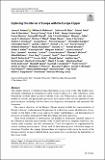Exploring the Interior of Europa with the Europa Clipper
Author(s)
Roberts, James H.; McKinnon, William B.; Elder, Catherine M.; Tobie, Gabriel; Biersteker, John B.; Young, Duncan; Park, Ryan S.; Steinbrügge, Gregor; Nimmo, Francis; Howell, Samuel M.; Castillo-Rogez, Julie C.; Cable, Morgan L.; Abrahams, Jacob N.; Bland, Michael T.; ... Show more Show less
Download11214_2023_Article_990.pdf (4.490Mb)
Publisher with Creative Commons License
Publisher with Creative Commons License
Creative Commons Attribution
Terms of use
Metadata
Show full item recordAbstract
Abstract
The Galileo mission to Jupiter revealed that Europa is an ocean world. The Galileo magnetometer experiment in particular provided strong evidence for a salty subsurface ocean beneath the ice shell, likely in contact with the rocky core. Within the ice shell and ocean, a number of tectonic and geodynamic processes may operate today or have operated at some point in the past, including solid ice convection, diapirism, subsumption, and interstitial lake formation.
The science objectives of the Europa Clipper mission include the characterization of Europa’s interior; confirmation of the presence of a subsurface ocean; identification of constraints on the depth to this ocean, and on its salinity and thickness; and determination of processes of material exchange between the surface, ice shell, and ocean.
Three broad categories of investigation are planned to interrogate different aspects of the subsurface structure and properties of the ice shell and ocean: magnetic induction, subsurface radar sounding, and tidal deformation. These investigations are supplemented by several auxiliary measurements. Alone, each of these investigations will reveal unique information. Together, the synergy between these investigations will expose the secrets of the Europan interior in unprecedented detail, an essential step in evaluating the habitability of this ocean world.
Date issued
2023-08-25Department
Massachusetts Institute of Technology. Department of Earth, Atmospheric, and Planetary SciencesPublisher
Springer Netherlands
Citation
Space Science Reviews. 2023 Aug 25;219(6):46
Version: Final published version